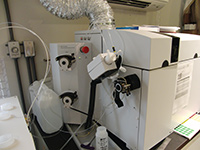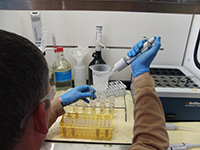

 |
 |
 |
 |
 |
 The Metals Retention Factor (MRF) was pioneered in 2013 by Mike Adams (the "Health Ranger"), the world's leading scientist on toxic element binding and retention in foods (because he has tested more foods for metals binding and retention than any other person alive, and he invented the scientific methodologies for doing so). Adams first revealed the MRF to the world on January 7, 2014.
The Metals Retention Factor (MRF) was pioneered in 2013 by Mike Adams (the "Health Ranger"), the world's leading scientist on toxic element binding and retention in foods (because he has tested more foods for metals binding and retention than any other person alive, and he invented the scientific methodologies for doing so). Adams first revealed the MRF to the world on January 7, 2014.
The existence of MRF means that many previous assumptions about foods and food toxicity are false. Previously, the assumption was the foods are fully broken down during digestion to release 100% of their elemental composition. This assumption turns out to be false. Foods, herbs and even dietary supplements actually retain a percentage of each toxic element they contain.
For example, one Traditional Chinese Medicine product tested by Adams retains around 70% of the lead it contains. Kelp granules tested by Adams retain 7% of the arsenic and 79% of the uranium they contain. Wheat flour retains nearly 12% of the aluminum is contains, and dried squid retains almost one-third of the toxic cadmium it contains.
In general, whole, raw, unprocessed foods have been found by Adams to retain much higher quantities of toxic elements, while cooked, processed or refined foods have been found to retain very low quantities of toxic elements and heavy metals. The retention of toxic elements is aided by insoluble fibers naturally found in whole foods. On top of that, some foods have a mysterious natural "ionic affinity" for certain elements that vastly multiply their metals capturing capacity for those elements. For example, most seafood (fish, shrimp, scallops, etc.) have a natural affinity for binding with cesium. This actually creates an increased risk for seafood in the Pacific Ocean to absorb radioactive cesium-137 being washed into the ocean from the Fukushima catastrophe.
QUESTIONING JUICING, LIQUID MINERALS AND VITAMIN POWDERS
Adams' discovery of the MRF means that nutritional products that lack natural fibers and are created through the isolation of food parts may present higher risk of heavy metals contamination for consumers. Juicing, for example, lacks all the protections of natural fibers. If the fresh produce used to create the juice is contaminated, there is no digestive defense against those toxic elements being absorbed into blood plasma. For this reason, fruits and vegetables used to make fresh juice need to be very carefully sourced to avoid contamination.
Similarly, liquid mineral supplements and vitamin / mineral powders need to be carefully looked at with additional testing to ensure they are not contaminated with toxic elements and heavy metals. Because they lack natural plant fibers, they suffer the same potential problem as fresh juice: even low levels of toxic elements can go right into blood plasma if they are present in the formulations. In other words, liquid minerals, vitamin powders and mineral powders need to be held to a much higher standard of cleanliness because they offer no natural buffers against the body's absorption of toxic elements.
Mike Adams is currently conducting comprehensive research on liquid minerals, fresh juice, fresh produce and vitamin powders in order to document their MRF numbers and elemental composition.
HOW THE MRF IS DETERMINED:
The following methodology was developed by Mike Adams, the "Health Ranger." A scientific paper describing the process in more detail is currently being composed.
The MRF is determined by first analyzing the elemental composition of a known quantity of the target substance via ICP-MS (Inductively Coupled Plasma Mass Spectroscopy). This process involves the use of nitric acid digestion and uses EPA-approved methodologies and external standards traceable to NIST standards. The ICP-MS used by Adams benefits from the presence of a Collision Reaction System (CRS) running He gas in conjunction with Argon to eliminate polyatomic interferences for vastly improved detection accuracy.
ICP-MS technology uses mass-to-charge ratio discrimination mass analyzers to determine the quantitative concentration of elements in any given solution.
While this sample is being analyzed via ICP-MS, a second sample of the same target substance is subjected to a digestion simulator designed to replicate as closely as possible the acidity, temperature, peristaltic motion and time duration of human digestion. This process involves the use of a precise quantity of a synthetic gastric acid made from high-purity ("trace grade") liquids. Adams uses a proprietary digestion simulation processed he developed at the lab.
Following digestion, the substance solids are separated from the liquids using a process designed to approximate the properties of the intestinal wall, which allows soluble liquids to pass through the wall and enter blood plasma.
The separated liquids are then subjected to ICP-MS analysis at parts per trillion (ppt) resolution, providing a precise measurement of the concentration of each element in the resulting liquid. This is compared to a blank synthetic gastric acid liquid which is subjected to the same analysis before digestion in order to establish the "blank" concentrations or "background" of all elements.
This ppt data is then compared to the elemental composition of the original substance using a series of chemical equations also developed by Mike Adams which take into account the precise volume of gastric acid used as well as the precise mass of the substance being tested. For quality control, these equations also take into account the quantitative elemental composition of multiple blanks, mid-range calibration checks and post-run calibration checks to account for "analysis drift."
The result is the MRF: a number between 0 and 1 which indicates what percentage of each element is retained by the solid matter vs. what percentage is released during digestion and allowed to enter blood plasma. An MRF of zero means the substance retains none of the element (releasing it all). An MRF of one means the substance retains all of the element. An MRF of .6 means the substance retains 60% of the element, releasing 40%.
In conducting this research, Mike Adams found that processed foods tended to have very low MRFs while intact, whole foods tended to have high MRFs. Processed sugars, starches and grains released most of their toxic elements into digestion, while foods high in insoluble fibers and pectins tended to retain the toxic elements and prevent them from being released into blood plasma. Adams will be published further research and, ultimately, many scientific papers that provide more precise details.
This research on the MRF has enormous implications for food safety, product formulations and national health care policies. It reveals, for example, that Chinese Medicine products containing high lead are not necessarily dangerous because many of them tend to retain their lead. Conversely, many processed foods which contain low levels of toxic heavy metals are actually more dangerous than superfoods with high heavy metals because processed foods have very low retention factors (and therefore tend to release toxic metals into blood plasma).
Adams' pioneering research on the Metals Retention Factor immediately made Proposition 65 in California obsolete.
Metals Retention Factor data for hundreds of foods, superfoods, beverages and dietary supplements is in the process of being published at Labs.NaturalNews.com